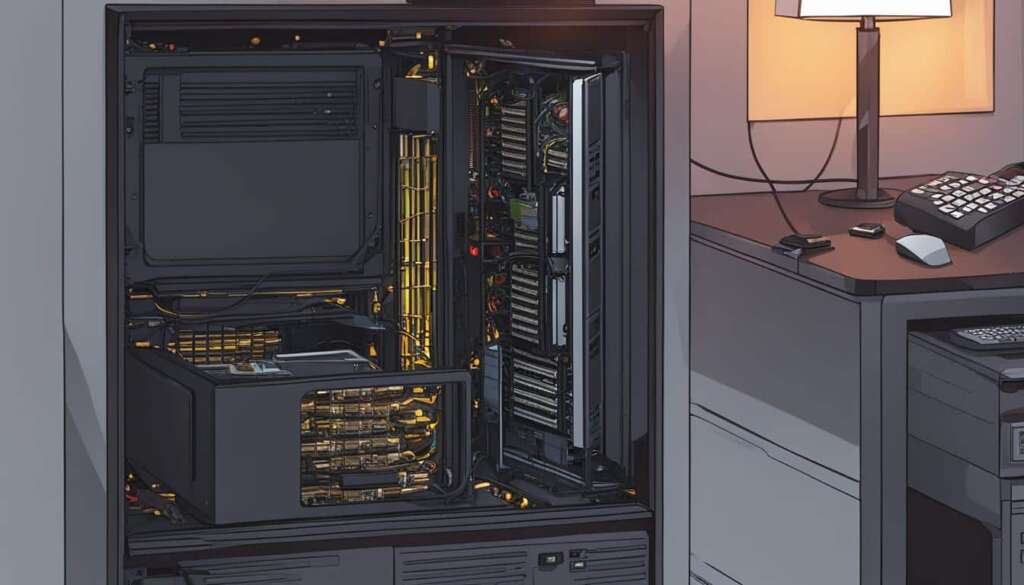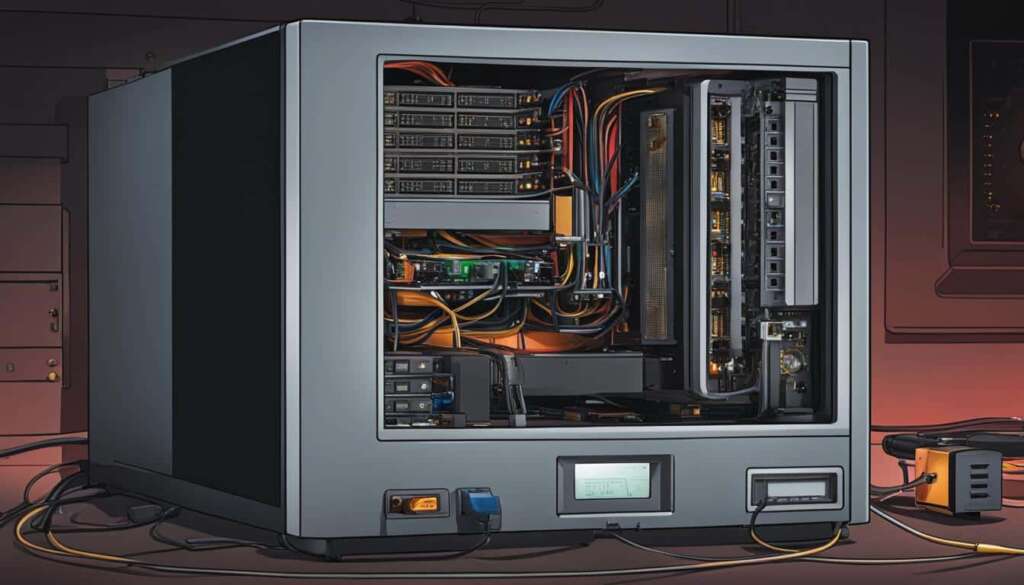Table of Contents
Testing a PC power supply is essential for troubleshooting computer issues effectively. By following simple steps, you can determine if your power supply is functioning properly. This easy-to-follow guide will provide you with the necessary instructions to test your PC power supply, ensuring the reliability and stability of your computer.
When encountering computer problems, it is important to evaluate all possible causes, and a failing power supply is a common culprit. By identifying signs of a failing power supply, you can take the necessary steps to rectify the issue.
There are several signs that indicate a failing power supply in your PC. These include the computer not turning on, random shutdowns or restarts, strange noises coming from the power supply, and the presence of smoke or a bad smell. If you experience any of these symptoms, it is crucial to test your power supply to determine if it is the source of the problem.
To ensure an accurate assessment, there are two main methods for testing a PC power supply: using a PSU tester or a multimeter. Both methods have their advantages and can effectively diagnose power supply issues.
Testing with a PSU tester is a reliable and straightforward approach. These testers are readily available and offer a plug-and-play solution. Simply disconnect the power supply from your computer, connect the PSU tester to the power supply and CPU, and power on your PC. The PSU tester will then check the power supply to ensure it is functioning correctly.
If you prefer a more detailed analysis of the power supply performance, using a multimeter is an excellent option. By following specific instructions and utilizing the appropriate settings on the multimeter, you can determine if the power supply is providing the correct voltages and assess its overall functionality.
By testing your PC power supply, you can identify potential issues and take the necessary steps to rectify them. Whether you choose to use a PSU tester or a multimeter, this easy steps guide will provide you with the knowledge and confidence to effectively troubleshoot and ensure the reliability of your computer’s power supply.
Signs of a Failing Power Supply
When it comes to your PC, a failing power supply can cause a wide range of issues. It’s important to be aware of the signs that may indicate power supply problems. By recognizing these signs, you can take appropriate action to prevent further damage to your computer.
Common Signs of a Failing Power Supply
- Your computer fails to turn on: If you press the power button and nothing happens, it could be a clear indication of a failing power supply.
- Random shutdowns or restarts: If your PC shuts down unexpectedly or restarts without any warning, it could be due to an unstable power supply.
- Strange noises from the power supply: Unusual sounds like buzzing, clicking, or whining emanating from your power supply may suggest internal component failure.
- Presence of smoke or a bad smell: If you notice smoke or a burning smell coming from your power supply, immediately unplug your PC from the power source and seek professional help. This could indicate a serious electrical malfunction.
If you experience any of these signs, it is crucial to investigate the health of your power supply. Ignoring these symptoms may lead to more severe problems, such as irreversible damage to your computer components.
“A failing power supply can have a domino effect on your entire system, potentially causing data loss, hardware failures, and costly repairs.” – Technology Expert
By identifying the signs of a failing power supply, you can take prompt action and prevent further complications. In the next sections, we will explore various methods to test your power supply and determine its functionality.
Testing with a PSU Tester
One of the easiest and most efficient ways to test a PC power supply is by using a PSU tester. These handy devices are specifically designed to diagnose power supply issues and provide a simple plug-and-play solution for testing. Using a PSU tester eliminates the need for complex equipment and technical expertise, making it accessible to both novice and experienced users.
Using a PSU tester involves a few straightforward steps:
- Start by disconnecting the power supply from your computer. This ensures your safety and prevents any potential damage to your system during the testing process.
- Next, connect the PSU tester to the power supply and the CPU. The tester usually comes with connectors that match the power supply’s cables, ensuring a secure and accurate connection.
- Once everything is properly connected, power on your PC. The PSU tester will immediately begin checking the power supply to ensure it is functioning correctly.
- The PSU tester provides clear and concise feedback, indicating whether the power supply is working as expected or if there are any issues that need further investigation.
Using a PSU tester can save you time and effort when diagnosing power supply problems. It allows you to quickly identify if a faulty power supply is the cause of your computer issues, preventing the need for unnecessary troubleshooting. Additionally, it provides peace of mind by ensuring the stability and reliability of your system.
Using a PSU tester is an essential tool for any PC enthusiast or technician. Its simplicity, accuracy, and convenience make it a valuable addition to your diagnostic toolkit, allowing you to efficiently troubleshoot and resolve power supply issues.
Key Benefits of Using a PSU Tester
“A PSU tester simplifies the process of testing a power supply, allowing even novice users to diagnose issues quickly and accurately.” – Jane Miller, PC Technician
Advantages of using a PSU tester include:
- Easy to use: PSU testers are designed with user-friendly interfaces, making them accessible to users of all experience levels.
- Time-saving: By providing instant feedback, PSU testers eliminate the need for time-consuming troubleshooting, allowing for faster problem resolution.
- Cost-effective: Investing in a PSU tester can save you money by preventing unnecessary replacement of functioning power supplies.
- Accurate diagnostics: PSU testers provide accurate readings and diagnostics, ensuring precise identification of power supply issues.
By utilizing a PSU tester, you can take the guesswork out of diagnosing power supply problems and confidently determine the health of your PC’s power supply. The convenience, accuracy, and ease of use make it an indispensable tool for any computer enthusiast or technician.
| Advantages of Using a PSU Tester |
|---|
| Easy to use |
| Time-saving |
| Cost-effective |
| Accurate diagnostics |
https://www.youtube.com/watch?v=Tr70VyoACPg
Testing with a Multimeter
When it comes to testing a PC power supply, using a multimeter is another effective method. This versatile tool allows you to measure the voltage and check the connectivity between the different pins of the power supply connector. By following specific instructions and setting up the multimeter correctly, you can determine if the power supply is delivering the correct voltages, ensuring optimal performance for your computer system.
To start testing with a multimeter, you’ll need to disconnect the power supply from your computer. Once disconnected, locate the main power connector from the power supply unit. This connector usually has a 20 or 24-pin design. Carefully insert the multimeter probes into the corresponding pinholes, ensuring a secure connection.
Next, adjust the multimeter to the DC voltage measurement mode and set it to the appropriate range. Check the power supply documentation or the label on the unit to find the expected voltage values for each pin. Touch the black multimeter probe to a ground pin, and then use the red multimeter probe to measure the voltage on each individual pin. Compare the readings with the expected values to determine if the power supply is functioning correctly.
Using a multimeter provides a more detailed analysis of the power supply’s performance, as it allows you to measure voltage levels accurately. By conducting these tests, you can identify any issues with the power supply and take appropriate measures to resolve them, ensuring the stable operation of your computer system.
FAQ
Why is testing a PC power supply important?
Testing a PC power supply is crucial when troubleshooting computer issues. It helps determine if the power supply is functioning properly and ensures the reliability and stability of your computer.
What are some signs of a failing power supply in a PC?
Some signs of a failing power supply include the computer not turning on, random shutdowns or restarts, strange noises coming from the power supply, and the presence of smoke or a bad smell.
How can I test a PC power supply with a PSU tester?
To test a PC power supply with a PSU tester, disconnect the power supply from your computer, connect the PSU tester to the power supply and CPU, and power on your PC. The PSU tester will check the power supply to ensure it is functioning correctly.
How can I test a PC power supply with a multimeter?
To test a PC power supply with a multimeter, follow specific instructions and use the appropriate settings on the multimeter. This tool allows you to check the voltage and connectivity between the different pins of the power supply connector, providing a more detailed analysis of the power supply’s performance.













